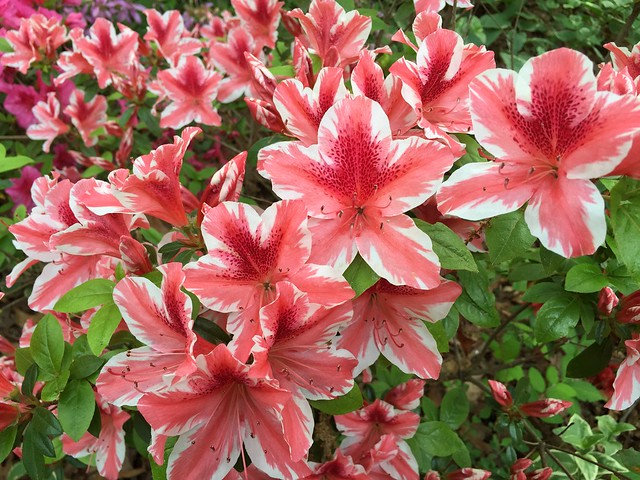Resource Library
Plant of the Week: Azalea - Ben Morrison
(680 words)
Plant of the Week: Azalea Ben Morrison
FAYETTEVILLE, Ark. -- I’m hooked on azaleas. I’ve been collecting them for 30 years, first starting with a late season freeze in the IGA parking lot. The plants had suffered badly and looked rough but for a buck apiece, how could I go wrong? Always on the prowl for new additions, a few years ago I stumbled upon ‘Ben Morrison’ Azalea, and it is quickly becoming a favorite.
Ben Morrison is an upright, evergreen rounded shrub that, if left unpruned, will reach 6 feet tall and wide in a decade. Like most azaleas, its evergreen characteristics are of the “kinda, sorta” variety. In warmer climates it will be more decidedly evergreen but on the boundary line between zone 6 and 7 where I garden, it loses many of its larger leaves but retains its smaller late season leaves. The larger leaves turn a modest yellow – brown before dropping in early winter.
The 2.5-inch wide single blooms are produced in late midseason for me -- the last of April to the first of May -- and last for about two weeks like most azaleas. The overall effect of the bloom is pink with an irregular jagged white border. Inside the pink field is a large blotch of dark red freckles concentrated on the upper three petals.
Ben Morrison Azalea was selected in 1968 from the azaleas growing at the Glenn Dale Plant Introduction Station in Glenn Dale, Maryland, by the then-director of the U.S. National Arboretum, John L. Creech (1920 – 2009). The plant was to commemorate the B.Y. Morrison Lecture Series that Secretary of Agriculture Orville Freeman initiated that year when he spoke to the Institute of Architects in Portland, Oregon.
Ben Morrison (1891- 1966) began his azalea breeding career in 1929 as part of his work for the Plant Introduction Station. This USDA-run facility was a receiving station for material plant explorers brought back from collecting trips around the world. His breeding goal was to develop large flowered, but winter hardy, azaleas such as seen in the milder parts of the southeastern states. Starting with the large flowered, but winter-tender Rhododendron indicum, he made crosses with more hardy species and cultivars. Between 1947 and 1949, he released 440 “Glenn Dale azaleas” to the nursery trade.
The parentage of Ben Morrison azalea is uncertain. The identity of the original Glenn Dale releases is well documented and followed by a spreadsheet full of “PI” and their corresponding “Bell” numbers. Creech could have selected it from a seedling population of a cross involving (‘Vittata Fortunei’ x ‘Louise’) by a Satsuki named ‘Azuma no Hana’. Or, just as likely, it could be from a set of Belgian azaleas x Glenn Dale hybrids that Creech dabbled with in the early 1960s. At any rate, the paperwork went awry and the parentage is lost on this fine plant.
Azaleas can be problematic to establish if attention is not paid to soil preparation prior to planting. They do best in a sandy, acidic soil – conditions few Arkansas gardeners are blessed with. However, by blending copious amounts of sand, pine bark and soil together (roughly a third of each) and planting the plants high in the planting bed, they can be grown to perfection. Azaleas are not heavy feeders but occasional feeding with an acid-forming fertilizer early in the growing season will assure good green color and promote late season bud set. While they will tolerate periodic bouts of drought, watering during prolonged dry spells will keep the plants healthy and prevent flower bud death.
Because of their Satsuki parentage it seems to me that many of the Glenn Dale azaleas benefit from more light than the Kurume azaleas. In a perfect world I would prefer a site that receives full sun all day until 2 or 3 in the afternoon when the heat of the late day sun would be blocked. Dappled light from a high canopy of shade trees is easier to find in most garden settings. But, if plants are producing only scant bloom displays, consider thinning the canopy to permit more light to enter.
